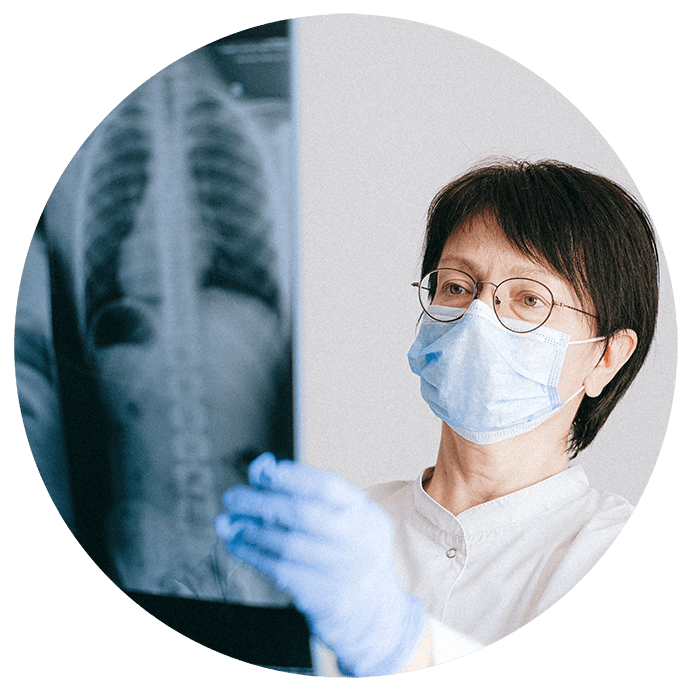
In a previous blog, we discussed the different types of bronchiectasis: cystic fibrosis bronchiectasis (CFB) and non-cystic fibrosis bronchiectasis (NCFB). Both conditions affect the lungs, making it difficult to breathe, clear mucus, and prevent the onset of respiratory infection.
When you consider each condition independently, it becomes easier to understand how they vary. CFB, for instance, would imply that a patient is living with a comorbid condition (i.e., CF and bronchiectasis). In contrast, NCFB would mean that a patient has bronchiectasis, but does not have cystic fibrosis.
The reason for this is a person living with CF can develop bronchiectasis symptoms over time, due to repeated damage to the lungs [1], but an individual living with bronchiectasis will not develop CF symptoms. 
 Differences Between Cystic Fibrosis and Bronchiectasis
Differences Between Cystic Fibrosis and Bronchiectasis
Though these conditions share many similarities—such as shortness of breath, chronic cough, infection, and obstructed airways [2]—their causes and how they affect the lungs are different.
Cystic fibrosis is a genetic condition. It damages more than the lungs, too. The condition develops when a child inherits two copies of the defective CF gene—one from each parent [3]. This mutation in the gene affects the protein that regulates the flow of salt in and out of one’s cells: “The result is thick, sticky mucus in the respiratory, digestive and reproductive systems, as well as increased salt in sweat” [4].
As with CF, bronchiectasis is an irreversible condition, meaning there is no known cure. However, bronchiectasis develops after repeated damage to the airways, which may result from several factors:

- Respiratory Illnesses (e.g., pneumonia, tuberculosis, or fungal infections) [5]
- Obstruction to the airways
- COPD (chronic obstructive pulmonary disease)
- Damaged cilia
- Cystic fibrosis
How Does Cystic Fibrosis Cause Bronchiectasis?
CF, like COPD, can put you at higher risk of developing bronchiectasis symptoms. This is primarily due to the fact that these chronic conditions can expose your lungs to repeated respiratory infection and inflammation. And without effective treatment, over time, your lungs and airways may become damaged, leading to bronchiectasis.

Treating Cystic Fibrosis and Bronchiectasis
Airway Clearance Therapy (ACT) has and continues to be utilized among patients living with CF [6]. It’s also an effective way to manage your bronchiectasis symptoms, as it helps to loosen and clear mucus buildup in the lungs.
Vest therapy, or high frequency chest wall oscillation (HFCWO) therapy, aids patients in clearing the airways of mucus by squeezing and releasing the upper chest wall. The oscillation of air helps loosen mucus buildup and propel it upwards, where it’s more easily coughed out.
As every individual is different, your treatment or therapy for CFB or NCFB will depend on your individual condition and other variables, including medications, health history, and symptoms.
To learn about the benefits of using HFCWO therapy via The SmartVest Airway Clearance System, schedule a time to chat with our Patient Care Advocate!
Find Support for CFB & NCFB
Whether you’re living with cystic fibrosis, bronchiectasis, or a comorbid condition, we invite you to stay connected to our community. We provide helpful articles, industry news, and resources for you and loved ones to read and share with your clinician.
Our goal is to educate and empower you to take an active role in your lung management and treatment.
Resources
[1] National Heart, Lung, and Blood Institute. “Bronchiectasis: Causes.” Retrieved from https://www.nhlbi.nih.gov/health-topics/bronchiectasis.
[2] Cystic Fibrosis Foundation. “About Cystic Fibrosis.” Retrieved from https://www.cff.org/What-is-CF/About-Cystic-Fibrosis/#:~:text=More%20than%2030%2C000%20people%20are,is%20age%2018%20or%20older.
[3] Cystic Fibrosis Foundation. “About Cystic Fibrosis.” Retrieved from https://www.cff.org/What-is-CF/About-Cystic-Fibrosis/#:~:text=More%20than%2030%2C000%20people%20are,is%20age%2018%20or%20older.
[4] Cystic Fibrosis. “Symptoms & Causes.” Retrieved from https://www.mayoclinic.org/diseases-conditions/cystic-fibrosis/symptoms-causes/syc-20353700.
[5] National Heart, Lung, and Blood Institute. “Bronchiectasis: Causes.” Retrieved from https://www.nhlbi.nih.gov/health-topics/bronchiectasis.
[6] Cystic Fibrosis Foundation. “About Cystic Fibrosis.” Retrieved from https://www.cff.org/What-is-CF/About-Cystic-Fibrosis/#:~:text=More%20than%2030%2C000%20people%20are,is%20age%2018%20or%20older.

